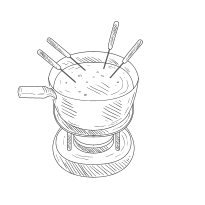How to Keep Cheese Fondue Warm: A Comprehensive Guide
Few culinary experiences are as convivial and satisfying as gathering around a bubbling pot of cheese fondue. The act of dipping crusty bread, fresh vegetables, and savory meats into a communal cauldron of melted cheese is a recipe for laughter, conversation, and unforgettable memories. But the success of any fondue party hinges on one crucial element: keeping the fondue at the perfect temperature – warm enough for smooth, dippable cheese, yet not so hot that it scorches or separates.
Understanding the Science Behind Warm Fondue
Before we delve into the how-to’s of fondue warmth maintenance, it’s helpful to understand the why’s. Cheese, primarily composed of fat and protein, behaves differently at varying temperatures. Heat is essential to melt the cheese and create that smooth, flowing consistency we all crave. However, excessive heat can cause the proteins to tighten, leading to a grainy, separated fondue – a culinary mishap no host wants to encounter.
The ideal temperature range for serving fondue is generally between 120°F and 140°F (50°C – 60°C). Within this Goldilocks zone, the cheese remains molten, dippable, and, most importantly, delicious. Now that we’ve established the why, let’s explore the how.
Methods for Keeping Cheese Fondue Warm
Maintaining your fondue’s ideal temperature doesn’t have to be a stressful balancing act. Here’s a rundown of the most popular and effective methods, each with its own set of pros and cons:
1. The Classic: Fondue Pot & Burner
The quintessential fondue set, featuring a ceramic or metal pot nestled atop a burner fueled by a small flame, remains a tried-and-true method. These sets are designed specifically for fondue, and their simple design effectively maintains a consistent heat source.
Pros:
- Even Heat Distribution: The design promotes consistent heat distribution, minimizing hot spots that could scorch the cheese.
- Adjustable Flame: Most burners offer adjustable flame intensity, allowing you to fine-tune the heat as needed.
- Aesthetic Appeal: Fondue pots often boast attractive designs, adding a touch of rustic charm to your table setting.
Cons:
- Open Flame: Requires careful supervision, especially around children and pets, due to the open flame.
- Fuel Management: You’ll need to monitor and replenish the fuel source (gel fuel, denatured alcohol, etc.) throughout the meal.
2. Modern Convenience: Electric Fondue Pots
For those who prioritize convenience and safety, electric fondue pots have emerged as a popular alternative. These pots typically feature an electric heating element built directly into the base, eliminating the need for open flames or messy fuels.
Pros:
- Safety First: No open flame reduces the risk of accidental burns and eliminates concerns about fuel fumes.
- Precise Temperature Control: Many electric models come equipped with temperature dials or digital controls for highly accurate heat regulation.
- Easy Cleanup: Most electric fondue pots have removable, dishwasher-safe bowls for hassle-free cleaning.
Cons:
- Cord Management: The power cord can sometimes be a minor inconvenience, requiring access to an electrical outlet.
- Less Traditional Aesthetic: While functional, electric fondue pots may lack the visual charm of their traditional counterparts.
3. DIY Approach: Slow Cooker Fondue
A surprising yet highly effective method involves using a slow cooker to keep your fondue warm. The gentle, consistent heat generated by a slow cooker is surprisingly well-suited for maintaining a luscious, dippable cheese sauce.
Pros:
- Hands-Off Convenience: Set the slow cooker to low and enjoy hours of perfectly warmed fondue without constant monitoring.
- Large Capacity: Slow cookers are ideal for larger gatherings, accommodating more fondue and more guests.
- Cost-Effective: If you already own a slow cooker, this method requires no additional investment.
Cons:
- Temperature Control: Most slow cookers lack precise temperature settings, so you may need to experiment to find the keep warm setting that works best for fondue.
- Less Portable: Slow cookers are generally bulkier and less portable than traditional fondue pots, making them less suitable for tabletop use during a meal.
4. Quick Fix: Chafing Dishes
While not specifically designed for fondue, chafing dishes, commonly used for buffets and catered events, can serve as a viable option for keeping cheese fondue warm.
Pros:
- Widely Accessible: Chafing dishes are often readily available at party supply stores or for rent from catering companies.
- Large Capacity: Similar to slow cookers, chafing dishes can accommodate large volumes of fondue, ideal for parties.
Cons:
- Heat Distribution: Chafing dishes can sometimes heat unevenly, so stirring the fondue periodically is essential.
- Temperature Control: Most chafing dishes offer limited temperature control, making it crucial to monitor the fondue’s consistency.
Tips for Fondue Success
Regardless of your chosen warming method, these tips will help ensure a smooth and enjoyable fondue experience:
1. Start with a Good Foundation
The quality of your fondue begins with the cheese. Opt for cheeses specifically designed for melting, such as Gruyère, Emmental, Fontina, or Comté. Avoid aged cheeses, which tend to become stringy when melted.
2. Mind Your Liquids
The liquid you use in your fondue recipe plays a vital role in its texture. Dry white wine is traditional, but you can also use beer, broth, or even milk. Adding a splash of lemon juice or a teaspoon of cornstarch can help prevent the cheese from separating.
3. Gradual Heating is Key
Patience is a virtue when it comes to fondue. Heat the cheese slowly over low to medium heat, stirring frequently to ensure even melting. Avoid rushing the process, as high heat can cause the cheese to curdle.
4. Keep It Moving
Stirring is your best friend throughout the fondue experience. Regular stirring ensures even heat distribution, prevents sticking, and maintains the smooth, creamy texture of the cheese sauce.
5. Adjust as Needed
Don’t be afraid to make adjustments as you go. If the fondue starts to thicken, add a splash of warm wine or broth. If it seems too thin, allow it to simmer gently for a few minutes to reduce slightly.
6. Embrace the Leftovers
Leftover cheese fondue? Don’t despair! It can be cooled, refrigerated, and reheated gently for another delicious meal. Try using it as a decadent topping for baked potatoes, pasta, or even pizza.
Conclusion
Keeping cheese fondue warm is a culinary dance of balance and attention. By understanding the factors that influence temperature and employing the right warming method, you can transform a simple gathering into a memorable celebration of cheesy goodness. So, gather your friends, break out the fondue forks, and prepare to indulge in the warmth and camaraderie of this timeless culinary tradition.

